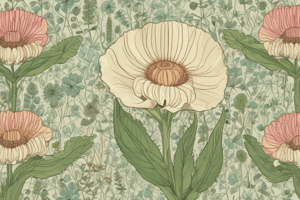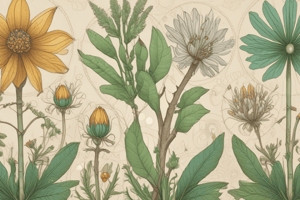Podcast
Questions and Answers
Which of the following stages is NOT part of a typical plant life cycle?
Which of the following stages is NOT part of a typical plant life cycle?
- Germination
- Pollination
- Seed dispersal
- Photosynthesis (correct)
The gametophyte stage of a plant life cycle is diploid (2n).
The gametophyte stage of a plant life cycle is diploid (2n).
False (B)
What is the name of the reproductive structure in flowering plants?
What is the name of the reproductive structure in flowering plants?
Flower
The process of transferring pollen from the anther to the stigma is called ______.
The process of transferring pollen from the anther to the stigma is called ______.
Match the following plant structures with their functions:
Match the following plant structures with their functions:
Which of the following is a key difference between angiosperms and gymnosperms?
Which of the following is a key difference between angiosperms and gymnosperms?
The seed coat provides nourishment for the developing embryo.
The seed coat provides nourishment for the developing embryo.
Name two environmental factors that can significantly impact a plant's life cycle.
Name two environmental factors that can significantly impact a plant's life cycle.
The ______ stage of a plant produces gametes through mitosis.
The ______ stage of a plant produces gametes through mitosis.
What is the primary role of seed dispersal in the plant life cycle?
What is the primary role of seed dispersal in the plant life cycle?
Which of these adaptations is NOT specifically designed for pollination?
Which of these adaptations is NOT specifically designed for pollination?
Angiosperms are distinguished by their enclosed seeds within an ovary.
Angiosperms are distinguished by their enclosed seeds within an ovary.
Explain one benefit of seed dispersal to a plant species.
Explain one benefit of seed dispersal to a plant species.
The process of transferring pollen from the anther to the stigma is known as ______.
The process of transferring pollen from the anther to the stigma is known as ______.
Match the seed dispersal mechanism with its corresponding example:
Match the seed dispersal mechanism with its corresponding example:
Asexual reproduction in plants results in offspring that are genetically identical to the parent plant.
Asexual reproduction in plants results in offspring that are genetically identical to the parent plant.
Which of these is NOT a factor influencing plant survival in different environments?
Which of these is NOT a factor influencing plant survival in different environments?
Explain how plant adaptations for wind pollination differ from those for insect pollination.
Explain how plant adaptations for wind pollination differ from those for insect pollination.
Gymnosperms are characterized by having ______ seeds.
Gymnosperms are characterized by having ______ seeds.
Which of the following is an example of a plant adaptation that allows for rapid population growth in a stable environment?
Which of the following is an example of a plant adaptation that allows for rapid population growth in a stable environment?
Flashcards
Plant Adaptations
Plant Adaptations
Evolved traits allowing survival and reproduction in varying environments.
Angiosperms
Angiosperms
Plants with enclosed seeds located in an ovary.
Gymnosperms
Gymnosperms
Plants whose seeds are exposed, lacking an ovary.
Wind Pollination
Wind Pollination
Signup and view all the flashcards
Attracting Pollinators
Attracting Pollinators
Signup and view all the flashcards
Seed Dispersal
Seed Dispersal
Signup and view all the flashcards
Asexual Reproduction
Asexual Reproduction
Signup and view all the flashcards
Genetic Diversity
Genetic Diversity
Signup and view all the flashcards
Pollination Strategies
Pollination Strategies
Signup and view all the flashcards
Dispersal Agents
Dispersal Agents
Signup and view all the flashcards
Plant Life Cycle
Plant Life Cycle
Signup and view all the flashcards
Germination
Germination
Signup and view all the flashcards
Alternation of Generations
Alternation of Generations
Signup and view all the flashcards
Gametophyte
Gametophyte
Signup and view all the flashcards
Sporophyte
Sporophyte
Signup and view all the flashcards
Flower Parts
Flower Parts
Signup and view all the flashcards
Pollination
Pollination
Signup and view all the flashcards
Factors Affecting Growth
Factors Affecting Growth
Signup and view all the flashcards
Study Notes
Plant Life Cycles
- Plants exhibit a remarkable diversity in their life cycles, varying greatly based on species and environmental conditions.
- Key stages of a typical plant life cycle include germination, vegetative growth, flowering, pollination, fertilization, seed development, and seed dispersal.
Alternation of Generations
- Many plants cycle between a haploid (n) gametophyte stage and a diploid (2n) sporophyte stage, a process called alternation of generations.
- Gametophyte: This stage produces gametes (sperm and egg cells) through mitosis.
- Sporophyte: This stage produces spores through meiosis; spores then develop into gametophytes.
- The relative importance of the gametophyte and sporophyte stages differs across plant groups.
Angiosperm Life Cycle
- Angiosperms (flowering plants) have a highly developed sporophyte, the dominant stage of their life cycle.
- The flower is the reproductive structure, housing both male (stamen) and female (carpel) parts.
- Stamen: Composed of the anther (producing pollen) and filament (supporting the anther).
- Carpel: Composed of the stigma, style, and ovary (containing ovules).
- Pollination occurs when pollen from the anther is transferred to the stigma.
- Fertilization involves sperm and egg fusion within the ovule, forming a zygote.
- The zygote develops into an embryo encased within a protective seed.
Gymnosperm Life Cycle
- Gymnosperms, like conifers, also exhibit alternation of generations, but their seeds are not enclosed within an ovary.
- Their life cycle involves cones housing both male and female reproductive structures.
- Pollen grains are transported to ovules by wind or other means.
Importance of Seed Structure
- The seed is crucial in the plant life cycle, nourishing and protecting the developing embryo.
- Seeds contain an embryo, endosperm (food for the embryo), and a seed coat (protective layer).
Factors Affecting Plant Growth
- Environmental factors significantly influence plant life cycles, including light, water, nutrients, temperature, and others.
- The timing of these factors is essential for successful seed germination, growth, and reproduction.
Plant Adaptations
- Plants have developed various adaptations for reproduction and survival in diverse environments.
- Examples include: seed and pollen dispersal methods (wind, water, animals); specialized pollination structures (flowers); and tolerance to different environmental conditions.
Key Differences Between Angiosperms and Gymnosperms
- Angiosperms have enclosed seeds (ovules in an ovary), whereas gymnosperms lack this enclosure; their seeds are exposed.
Reproduction Strategies
- Some plants rely on wind pollination (e.g., grasses), while others have evolved features to attract specific pollinators (e.g., bright colors, fragrances, nectar).
- Diverse pollination methods ensure species survival and genetic diversity.
Seed Dispersal Mechanisms
- Seed dispersal mechanisms help plants colonize new locations and avoid competition with parent plants.
- Seeds are dispersed by wind, water, animals, or other means.
Asexual Reproduction
- Some plants reproduce asexually, creating genetically identical offspring from a single parent.
- This method enables rapid population growth in stable environments.
Studying That Suits You
Use AI to generate personalized quizzes and flashcards to suit your learning preferences.




